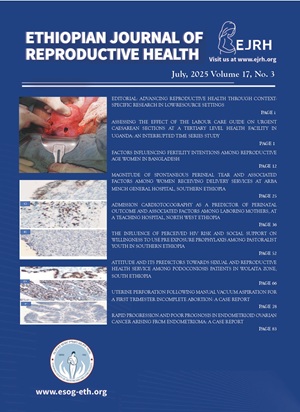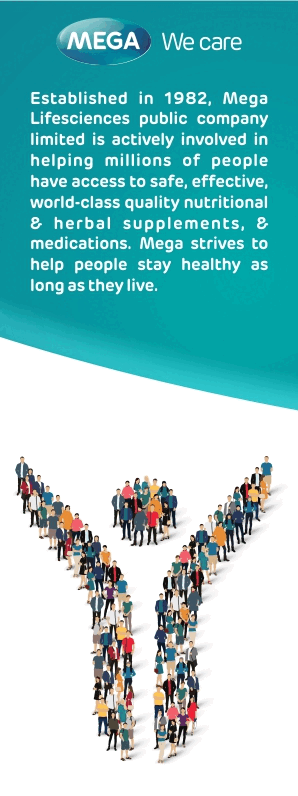THE ROLES OF PERCEIVED HIV RISK AND SOCIAL SUPPORT IN WILLINGNESS TO USE PRE EXPOSURE PROPHYLAXIS AMONG PASTORAL YOUTH OF SOUTHERN ETHIOPIA.
DOI:
https://doi.org/10.69614/ejrh.v17i3.916Keywords:
HIV prevention, pre exposure prophylaxis, pastoralist youth, risk perception, social support, EthiopiaAbstract
BACKGROUND: Pastoralist youth experience a high HIV vulnerability yet have limited access to prevention services. Pre exposure prophylaxis (PrEP) could close this gap, but little is known about factors of PrEP willingness among pastoralist youth.
OBJECTIVE: To examine whether (i) empirically derived HIV risk status predicts willingness to use PrEP, (ii) perceived HIV risk mediates this association, and (iii) social support moderates the pathway from perceived risk to willingness among pastoral youth.
METHODS: A population based cross sectional survey was conducted among 638 randomly selected pastoralist youth (15–24 years) in Southern Ethiopia (April–May 2024). HIV risk status was derived with a 3 class latent class analysis of nine behavioral and structural HIV risk indicators. Perceived risk (mediator), social support (moderator) and PrEP willingness were measured by interviewer administered questionnaire. PROCESS macro v4.2 in SPSS tested mediation (Model4) and moderated mediation (Model15) with 5000 bias corrected bootstrap samples, controlling for age and sex.
RESULTS: Overall, 40.4% of participants were definitely willing to use PrEP. High risk youth were more willing than low risk peers (adjusted =0.92, p<0.001). Perceived HIV risk partially mediated this link (indirect =0.20, 95 CI0.10–0.35). Social support significantly intensified the effect of perceived risk on willingness (index of moderated mediation=0.21, 95 CI0.03–0.43): among youth with high social support the mediated effect increased relative to those with low support.
CONCLUSION: Accurate self assessment of HIV risk is limited among pastoral youth, yet when risk is acknowledged, supportive social networks amplify motivation to use PrEP. Interventions should pair risk communication strategies with social support to enhance PrEP uptake.
References
Joint United Nations Programme on HIV/AIDS (UNAIDS). AIDS statistics—Fact sheet [Internet]. Geneva: UNAIDS; 2023 [cited 2025 Jan 19]. Available from: https://www.unaids.org/sites/default/files/media_asset/UNAIDS_FactSheet_en.pdf
Masquelier B, Hug L, Sharrow D, You D, Mathers C, Gerland P, et al. Global, regional, and national mortality trends in youth aged 15–24 years between 1990 and 2019: a systematic analysis. Lancet Glob Health. 2021;9(4):e409-e417.
World Health Organization (WHO). Pre-exposure prophylaxis (PrEP) [Internet]. Geneva: WHO, Global HIV Programme; 2023 [cited 2025 Feb 1]. Available from: https://www.who.int/teams/global-hiv-hepatitis-and-stis-programmes/hiv/prevention/pre-exposure-prophylaxis
Centers for Disease Control and Prevention (CDC). Pre-Exposure Prophylaxis (PrEP) [Internet]. Atlanta: CDC; 2022 Jul 5 [cited 2025 Jan 9]. Available from: https://www.cdc.gov/hiv/risk/prep/index.html
Owens DK, Davidson KW, Krist AH, Barry MJ, Cabana M, Caughey AB, et al. Preexposure prophylaxis for the prevention of HIV infection: US Preventive Services Task Force recommendation statement. JAMA. 2019;321(22):2203-2213.
World Health Organization (WHO). WHO implementation tool for pre-exposure prophylaxis (?PrEP)? of HIV infection: module 12: adolescents and young adults [Internet]. Geneva: WHO; 2018 [cited 2025 Apr 1]. Available from: https://iris.who.int/handle/10665/273172
Irungu EM, Baeten JM. PrEP rollout in Africa: status and opportunity. Nat Med. 2020;26(5):655-664.
AVAC. PrEPWatch: Explore data and information on PrEP across the globe [Internet]. New York: AVAC; [cited 2024 Oct 8]. Available from: https://www.prepwatch.org/
Gbaja-Biamila T, Obiezu-Umeh C, Nwaozuru U, Rosenberg NE, Igbokwe M, Oladele D, et al. Awareness of, willingness to use, and experiences with Pre-exposure prophylaxis among youth in Nigeria. BMC Health Serv Res. 2024;24(1):1-10.
Taggart T, Liang Y, Pina P, Albritton T. Awareness of and willingness to use PrEP among Black and Latinx adolescents residing in higher prevalence areas in the United States. PLoS One. 2020;15(7):e0234821. Available from: https://doi.org/10.1371/journal.pone.0234821
Hill LM, Maseko B, Chagomerana M, Hosseinipour MC, Bekker LG, Pettifor A, et al. HIV risk, risk perception, and PrEP interest among adolescent girls and young women in Lilongwe, Malawi: operationalizing the PrEP cascade. J Int AIDS Soc. 2020;23:e25502. Available from: https://doi.org/10.1002/jia2.25502
Agwang W, Nangendo J, Nabikande S, Okello T, Tusabe J, Semitala FC, et al. Factors associated with willingness to take Pre-Exposure Prophylaxis (PrEP) among high-risk adolescent boys and young men in Masese fishing community, Uganda. PLOS Glob Public Health. 2023;3(6):e0001191. Available from: https://doi.org/10.1371/journal.pgph.0001191
Ssuna B, Katahoire A, Armstrong-Hough M, Kalibbala D, Kalyango JN, Kiweewa FM. Factors associated with willingness to use oral pre-exposure prophylaxis (PrEP) in a fisher-folk community in peri-urban Kampala, Uganda. BMC Public Health. 2022;22(1):468.
Gordián-Arroyo A, Garofalo R, Kuhns LM, Pearson C, Bruce J, Batey DS, et al. Awareness, willingness, and perceived efficacy of pre-exposure prophylaxis among adolescent sexual minority males. J Urban Health. 2020;97:749-757.
Warren EA, Paterson P, Schulz WS, Lees S, Eakle R, Stadler J, et al. Risk perception and the influence on uptake and use of biomedical prevention interventions for HIV in sub-Saharan Africa: a systematic literature review. PLoS One. 2018;13(6):e0198680. Available from: https://doi.org/10.1371/journal.pone.0198680
Gammino VM, Diaz MR, Pallas SW, Greenleaf AR, Kurnit MR. Health services uptake among nomadic pastoralist populations in Africa: A systematic review of the literature. PLOS Negl Trop Dis. 2020;14(7):e0008474. Available from: https://doi.org/10.1371/journal.pntd.0008474
Zepro NB, Ali NT, Tarr N, Medhanyie AA, Paris DH, Probst-Hensch N, et al. Sexual and reproductive health services use among adolescents in pastoralist settings, northeastern Ethiopia. BMC Health Serv Res. 2023;23(1):677.
Nunn AS, Brinkley-Rubinstein L, Oldenburg CE, Mayer KH, Mimiaga M, Patel R, et al. Defining the HIV pre-exposure prophylaxis care continuum. AIDS. 2017;31(5):731-4.
Scott HM, Pollack L, Rebchook GM, Huebner DM, Peterson J, Kegeles SM. Peer social support is associated with recent HIV testing among young black men who have sex with men. AIDS Behav. 2014;18:913-920.
Skakoon-Sparling S, Berlin G, Lachowsky NJ, Moore DM, Lambert G, Cox J, et al. Social support and HIV prevention behaviors among urban HIV-negative gay, bisexual, and other men who have sex with men. Health Psychol. 2022;41(1):65.
Alemneh A, Alemu A. Pastoralism and conflict transformation in Nyangatom, hammer, and dassanech community of Ethiopia. J Soc Transform Reg Dev. 2023;5(2). Available from: https://doi.org/10.30880/jstard.2023.05.02.010
Raykov T, Harrison M, Marcoulides GA. Examining class separation contribution by observed indicators in latent class models: A multiple testing procedure. Struct Equ Modeling. 2019;27(1):88-96. Available from: https://doi.org/10.1080/10705511.2018.1554446
Zimet GD, Dahlem NW, Zimet SG, Farley GK. The multidimensional scale of perceived social support. J Pers Assess. 1988;52(1):30-41.
Zakiei A, Norouzi? E, Ghasemi SR, Komasi S, Rostampour M, Khazaie H. Controlling risky behavior associated with AIDS: the role of social support, family functioning, self-efficacy and AIDS risk perception. BMC Psychol. 2022;10(1):132.
Banstola RS, Ogino T, Inoue S. Self-esteem, perceived social support, social capital, and risk-behavior among urban high school adolescents in Nepal. SSM Popul Health. 2020;11:100570. Available from: https://doi.org/10.1016/j.ssmph.2020.100570
Hayes AF. Introduction to mediation, moderation, and conditional process analysis: A regression-based approach. New York: Guilford Publications; 2017.
Ngere SH, Aduda DO, Nyambuga CO, Oduor PA, Awuoche HA, Nyanjom MA, et al. Exposure and predictors of intention to use HIV pre-exposure prophylaxis (PrEP) among adolescent girls and young women: assessment of Jipende JiPrEP campaign in Kisumu, Kenya. PAMJ One Health. 2021;4(3).
Shamu S, Shamu P, Khupakonke S, Farirai T, Chidarikire T, Guloba G, et al. Pre-exposure prophylaxis (PrEP) awareness, attitudes and uptake willingness among young people: gender differences and associated factors in two South African districts. Glob Health Action. 2021;14(1):1886455. Available from: https://doi.org/10.1080/16549716.2021.1886455
Eisingerich AB, Wheelock A, Gomez GB, Garnett GP, Dybul MR, Piot PK. Attitudes and acceptance of oral and parenteral HIV preexposure prophylaxis among potential user groups: a multinational study. PLoS One. 2012;7(1):e28238. Available from: https://doi.org/10.1371/journal.pone.0028238
Peng P, Su S, Fairley CK, Chu M, Jiang S, Zhuang X, et al. A global estimate of the acceptability of pre-exposure prophylaxis for HIV among men who have sex with men: a systematic review and meta-analysis. AIDS Behav. 2018;22:1063-1074.
Rankin KA. Is Risk Compensation Real? The Effect of Perceived Level of HIV Acquisition on Risk Behavior in a Pilot Pre-exposure Prophylaxis Demonstration Project in Men Who Have Sex with Men in Malaysia [dissertation]. New Haven (CT): Yale University; 2023.
Krajewski T, LeMasters KH, Oser CB, Brinkley-Rubinstein L. Perceived versus actual HIV risk among PrEP indicated persons with criminal legal involvement. AIDS Care. 2024:1-10.
Cohen S, Wills TA. Stress, social support, and the buffering hypothesis. Psychol Bull. 1985;98(2):310-57.
Uchino BN. Social support and health: A review of physiological processes potentially underlying links to disease outcomes. J Behav Med. 2006;29(4):377-87.
Kudowa E, Chagomerana M, Phanga T, Maseko B, Price JT, Hosseinipour MC, et al. Incidence rate and predictors of HIV incidence among adolescent girls and young women in Lilongwe, Malawi. Presented at: 10th IAS Conference on HIV Science; 2019 Jul 21-24; Mexico City, Mexico.
Schaefer R, Gregson S, Fearon E, Hensen B, Hallett TB, Hargreaves JR. HIV prevention cascades: a unifying framework to replicate the successes of treatment cascades. Lancet HIV. 2019;6(1):e60-e66.



